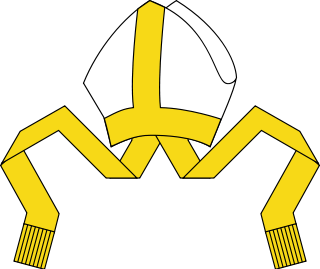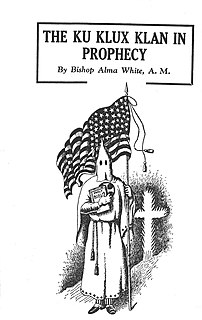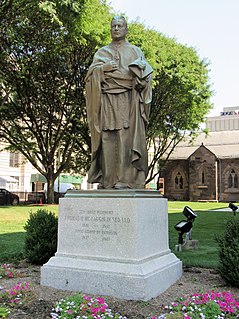
James Edwin Coyle was a Catholic priest who was murdered in Birmingham, Alabama.

The Diocese of Paterson is a Latin Church ecclesiastical territory or diocese of the Catholic Church in the United States that encompasses Passaic, Morris, and Sussex counties in northern New Jersey. Most of this territory lies to the west of the episcopal see in Paterson. As of 2013, there were 166 active diocesan priests, 96 retired priests, 124 religious priests, 136 permanent deacons, 19 retired permanent deacons, 178 male religious and 677 female religious to serve 426,000 Catholics out of a total population of 1,143,500, ranking it 44th in Catholic population among dioceses in the United States. The patrons of the diocese are St. Patrick and St. John the Baptist, and its proper feasts are the Feast of St. Patrick, the Nativity of John the Baptist, the anniversary of the dedication of the cathedral church. The diocese is a suffragan diocese in the ecclesiastical province of the metropolitan Archdiocese of Newark, and is part of Region III of the United States Conference of Catholic Bishops.

Arthur Joseph Serratelli is an American prelate of the Roman Catholic Church. He served as bishop of the Diocese of Paterson in New Jersey from 2004 to 2020 and as an auxiliary bishop for the Archdiocese of Newark in New Jersey between 2000 and 2004.

The Archdiocese of Newark is a Latin Church ecclesiastical jurisdiction or archdiocese of the Catholic Church in northeastern New Jersey, United States. Its ecclesiastic territory includes all of the Catholic parishes and schools in the New Jersey counties of Bergen, Union, Hudson and Essex.

Garret Mountain Reservation is a 568-acre (230 ha) park located on First Watchung Mountain in Paterson and Woodland Park in southern Passaic County, New Jersey. In 1967, it was designated a National Natural Landmark as part of the Great Falls of Paterson-Garret Mountain listing. The park extends into Clifton. Garret Mountain is Passaic County's major recreational area, providing the visitors with grass fields, several miles of walking/running trails, basketball courts, picnic areas, Barbour's Pond is state stocked with fish for anglers, as well as an Equestrian Center with horseback riding lessons.

The National Shrine of the Little Flower Basilica Catholic Church is a Catholic church in Royal Oak, Michigan. A designated national shrine, the church building is well-known for its execution in the lavish zig-zag Art Deco style. The structure was completed in two stages between 1931 and 1936. The sanctuary, at 2100 West Twelve Mile Road at the northeast corner of Woodward Avenue, is a parish of the Archdiocese of Detroit. Its construction was funded by the proceeds of the radio ministry of the controversial Father Charles Coughlin, who broadcast from its tower in the 1930s.

Arthur Hornbui Bell was an attorney and the Grand Dragon of the Ku Klux Klan in New Jersey.

Frank Joseph Rodimer was an American prelate of the Catholic Church. He served as the sixth Bishop of Paterson from 1977 to 2004.

The Good Citizen was a sixteen-page monthly political periodical edited by Bishop Alma White and illustrated by Reverend Branford Clarke. The Good Citizen was published from 1913 until 1933 by the Pillar of Fire Church at their headquarters in Zarephath, New Jersey in the United States. White used the publication to expose "political Romanism in its efforts to gain the ascendancy in the U.S."

The Ku Klux Klan in Prophecy is a 144-page book written by Bishop Alma Bridwell White in 1925 and illustrated by Reverend Branford Clarke. In the book she uses scripture to rationalize that the Ku Klux Klan is sanctioned by God "through divine illumination and prophetic vision". She also believed that the Apostles and the Good Samaritan were members of the Klan. The book was published by the Pillar of Fire Church, which she founded, at their press in Zarephath, New Jersey. The book sold over 45,000 copies.
Joseph John Rice was an American prelate of the Roman Catholic Church. He served as bishop of the Diocese of Burlington in Vermont from 1910 to his death.

Thomas Henry McLaughlin was an American prelate of the Roman Catholic Church who served as President of Seton Hall College (1922–1933) and Bishop of Paterson, New Jersey (1937–1947).
Alton Milford Young was the Grand or Imperial Kaliff and the Imperial Kludd of the Ku Klux Klan in New Jersey. The Imperial Kludd is the chaplain of the Imperial Klonvokation and he performs "such other duties as may be required by the Imperial Wizard." The Imperial Kaliff is the second highest position after the Imperial Wizard.

The Ku Klux Klan has had a history in the U.S. state of New Jersey since the early part of the 1920s. The Klan was active in the areas of Trenton and Camden and it also had a presence in several of the state's northern counties in the 1920s. It had the most members in Monmouth County, and operated a resort in Wall Township.

Guardians of Liberty is a three volume set of books published in 1943 by Bishop Alma Bridwell White, author of over 35 books and founder of the Pillar of Fire Church. Guardians of Liberty is primarily devoted to summarizing White's vehement anti-Catholicism under the guise of patriotism. White also defends her historical support of and association with the Ku Klux Klan while significantly but not completely distancing herself from the Klan. Each of the three volumes corresponds to one of the three books White published in the 1920s promoting the Ku Klux Klan and her political views which in addition to anti-Catholicism also included nativism, anti-Semitism and white supremacy. In Guardians of Liberty, White removed most, but not all of the direct references to the Klan that had existed in her three 1920s books, both in the text and in the illustrations. In Volumes I and II, she removed most of the nativist, anti-Semitic and white supremacist ideology that had appeared in her predecessor books. However, in Guardians Volume III, she did retain edited versions of chapters promoting nativism, anti-Semitism and white supremacy.

The Cathedral of St. John the Baptist is a historic Catholic cathedral and parish church located in Paterson, Passaic County, New Jersey, United States. It is the seat of the Roman Catholic Diocese of Paterson. The cathedral was listed on the National Register of Historic Places in 1977.

St. Nicholas Roman Catholic Church is a Catholic parish in Passaic, Passaic County, New Jersey, United States, in the Diocese of Paterson. It should not be confused with St. Nicholas Ukrainian Catholic Church, also located in Passaic.
Leo Thomas Maher was an American prelate of the Roman Catholic Church. He served as Bishop of Santa Rosa (1962–1969) and Bishop of San Diego (1969–1990).
The 1880 Garret Rock May Day riot or 1880 Garret Mountain May Day riot was a civil disorder event in New Jersey, that protested harshly oligarchical power.

The Ku Klux Klan is an organization that expanded operations into Canada, based on the second Ku Klux Klan established in the United States in 1915. It operated as a fraternity, with chapters established in parts of Canada throughout the 1920s and early 1930s. The first registered provincial chapter was registered in Toronto in 1925 by two Americans and a Torontonian. The organization was most successful in Saskatchewan, where it briefly influenced political activity and whose membership included a member of Parliament, Walter Davy Cowan.

















